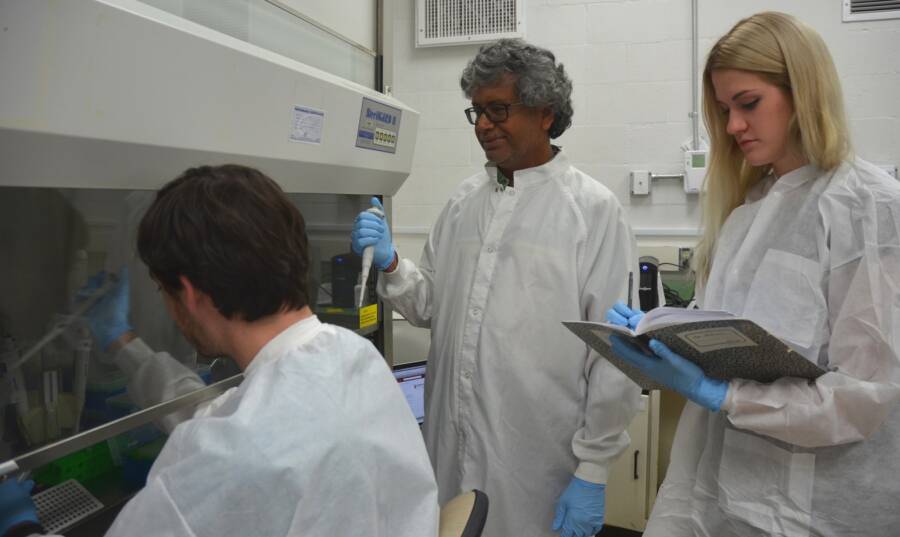Scientists Find Radiation-Eating Fungi At Chernobyl — And Now Seek To Harness Their Power
By Natasha Ishak
Published February 7, 2020
Scientists hope to use the fungi's abilities for those routinely exposed to radiation, like cancer patients, nuclear power plant engineers, and astronauts.
Abandoned Chernobyl Box Office

Getty Images
Since the Chernobyl nuclear explosion in 1986, species of fungi have been thriving off the radiation in these now-abandoned areas.
Whether it’s an asteroid or an ice age, planet Earth and its lifeforms always seem to find a way to carry on. Recently, scientists found that a few particularly impressive little lifeforms were even able to survive in an environment as harsh as Chernobyl.
The 1986 Chernobyl nuclear disaster remains the worst such incident in recorded history and has killed thousands over the years. Even decades later, radiation in Chernobyl’s surrounding area lingers, but this hot spot has also become a mecca for a certain type of fungi.
According to Popular Mechanics, scientists discovered at least 200 species and 98 genera of fungi thriving off radiation at the infamous disaster site. The astounding discovery was first documented in 1991 when scientists found fungi growing on the walls of the abandoned nuclear reactor which was still covered in gamma radiation.
Stunned, researchers began studying the organisms, known as “black fungi” due to their concentrations of melanin, and found that three different species were living off of the gamma radiation. These strains, Cladosporium sphaerospermum, Cryptococcus neoformans, and Wangiella dermatitidis, were even all found to grow faster in the presence of the radiation and even grow toward it as if naturally drawn to it.
Black Fungus Being Tested

NASA/JPL/CALTECH
Strain of black fungi being tested in the lab.
“The fungi collected at the accident site had more melanin than the fungi collected from outside the exclusion zone,” Kasthuri Venkat, a senior researcher at NASA and the lead scientist on the agency’s space fungi project, told Vice.
“This means the fungi have adapted to the radiation activity and as many as twenty percent were found to be radiotrophic—meaning they grew towards the radiation; they loved it.”
Because the fungi contain so much melanin, they are able to feed off the gamma rays and convert them into chemical energy, kind of like a darker version of photosynthesis. This process is called radiosynthesis.
“The presumption has always been that we don’t know why truffles and other fungi are black,” explained Arturo Casadevall, a microbiologist and co-author of the previous study. “If they have some primitive capacity to harvest sunlight or to harvest some kind of background radiation a lot of them would be using it.”
Chernobyl Disaster Workers Preparing For Cleanup IGOR KOSTIN, SYGMA/CORBIS “Liquidators” at the sight of the Chernobyl disaster preparing for cleanup, 1986.

This has led scientists to wonder whether the melanin in human skin cells could turn radiation into “food” too, but for now, they believe this is a stretch. However, they not ruling this possibility out for other lifeforms.
“The fact that it occurs in fungi raises the possibility that the same may occur in animals and plants,” Casadevall added. Scientists have thus been working to extract the radiation-absorbing power of Chernobyl’s fungi for the good of humankind in a number of ways.
One of these ways would be finding an application for the fungi’s capabilities in protecting those routinely exposed to radiation, like cancer patients and nuclear power plant engineers. Scientists also hope that the fungi could be used to develop a biological source of energy via radiation conversion.

Aerial View Of Reactor 4 In 1986 SHONE/GAMMA/Gamma-Rapho via Getty Images
View of the Chernobyl nuclear power plant after the explosion. April 26, 1986.
Meanwhile, another proposed application for the powers of these fungi lies in space travel.
In 2016, SpaceX and NASA sent a package to the International Space Station (ISS) containing several strains of fungi from Chernobyl. The shipment also included more than 250 different tests for the space crew to carry out.
Why space? The molecular changes that researchers observed in the Chernobyl fungi were brought on by the stress created from exposure to the site’s radiation. Researchers hoped to replicate this reaction in space, where they planned to expose the fungi to the stresses of microgravity and compare them with similar strains of fungi from Earth.
The results of the NASA study could have great benefits for future space travel, possibly allowing astronauts a way to protect themselves from deadly amounts of cosmic radiation. Findings from these investigations aboard the ISS will soon be published in an upcoming paper.

Scientists In Lab NASA/JPL/CALTECH Kasthuri Venkateswaran and interns examining radiation-eating fungi.
It’s not just fungi that have been able to flourish so effectively despite the radiation. Over the years, scientists have found an abundance of wildlife thriving in Chernobyl’s former Red Zone and at the site of the Fukushima nuclear disaster in Japan.
In Chernobyl and across Earth’s most dangerous zones of radioactivity, life keeps finding a way to adapt to even the harshest of environments.
Next, take a look at haunting photos of Chernobyl today after being frozen in time by the nuclear meltdown and read about Anatoly Dyatlov, the man behind the Chernobyl disaster.
No comments:
Post a Comment